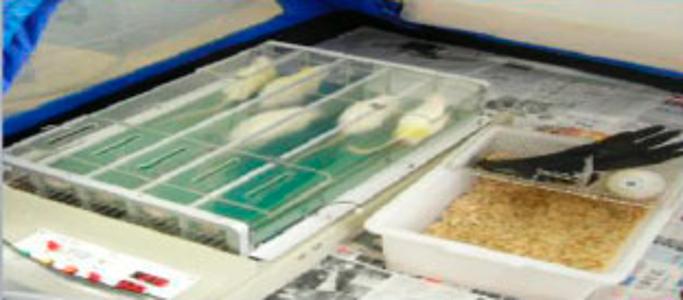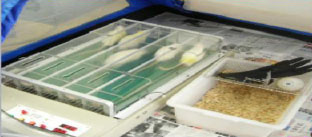| [1] 余群,翁锡全,林文弢,等.间歇低氧预防SD大鼠大运动负荷训练期血红蛋白下降及其机制探讨[J].中国运动医学杂志, 2010, 29(4):399-402.[2] Kish WS, Roach MK, Sachi H, et al. Purification of human erythropoietin by affinity chromatography using cyclic peptide ligands.J Chromatogr B Analyt Technol Biomed Life Sci. 2018; 1085:1-12.[3] 刘铁牛,黄强,陈要朋.1658例新兵复检血细胞分析参数异常报警分析[J].检验医学与临床, 2014,z2: 264-266.[4] 冯连世,赵中应,洪平,等.模拟高原训练对大鼠促红细胞生成素表达的影响[J].中国运动医学杂志,2001,20(4):358-360.[5] Kim CK. Son HJ, Kim HJ, et al. Erythropoietin, 2,3 DPG, oxygen transport capacity, and altitude training in adolescent Alpine skiers.Aviat Space Environ Med. 2012;83(1):50-53.[6] P?oszczyca K, Langfort J, Czuba M. The Effects of altitude training on erythropoietic response and hematological variables in adult athletes: A Narrative Review. Front Physiol. 2018;9:375.[7] Liu J, Zhang SK, Luo JM, et al.Changes in cerebrovascular reactivity in healthy adults after acute exposure to high altitude. Eur Rev Med Pharmacol Sci. 2018;22(5):1437-1450.[8] 赵杰修,田野,曹建民,等.不同运动方式对大鼠血红蛋白浓度的影响-大鼠运动性贫血模型建立方法探讨.中国运动医学杂志, 2004,23(4):436-440.[9] 叶剑飞,余闽,岑浩望.过度训练的病理生理及康复-工人鼠过度训练模型的建立[J].中国运动医学杂志,1992, 11(2):15-31.[10] 张缨,文茹.运动性贫血的发生机制与监测[J].北京体育大学学报, 2001,24(3):331-334.[11] Eichner ER. Anemia in Athletes, News on iron therapy, and community care during marathons. Curr Sports Med Rep. 2018;17(1):2-3.[12] Parks RB, Hetzel SJ, Brooks MA. Iron Deficiency and anemia among collegiate athletes: a retrospective chart review. Med Sci Sports Exerc. 2017;49(8):1711-1715.[13] Vogt M, Puntschart A, Geiser C, et al. Molecular adaptations in human skeletal muscle to endurance training simulate hypoxic conditions. J Appl Physiol.2001;91:171-182.[14] Czuba M, Waskiewicz Z, Zajac A, et al. The effects of intermittent hypoxic training on aerobic capacity and endurance performance in cyclists. J Sports Sci Med. 2011; 10(1):175-183.[15] Carr AJ, Saunders PU, Vallance BS, et al. Increased hypoxic dose after training at low altitude with 9h per night at 3000m normobaric hypoxia. J Sports Sci Med. 2015;14(4):776-782. [16] Hamlin MJ, Hellemans J. Effects of intermittent nor-mobaric hypoxia on blood parameters in multi-sport endurance athletes. Am College Sports Med Held.2004;2:5. [17] Berezovskii VA,Litovka IG, Kostyuchenko AS. Low oxygen [correction of oxygene] tension may defence the bone tissue from unloading simulated osteopenia. J Gravit Physiol. 2004; 11(2):153-154. [18] Jacobs RA, Lundby C, Robach P, et al. Red blood cell volume and the capacity for exercise at moderate to high altitude. Sports Med. 2012;42(8):643-63. [19] Dehnert C, Hutler M, Liu Y, et al. Erythropoiesis and performance after two weeks of living high and training low in well trained triathletes. Int J Sports Med. 2002;23(8):561.[20] Goh SH, Josleyn M, Lee YT, et al. The human reticulocyte transcriptome. Physiol Genomics. 2007;30(2):172-178.[21] Wehrlin JP, Zuest P, Hallén J, et al. Live high-train low for 24 days increases hemoglobin mass and red cell volume in elite endurance athletes. J Appl Physiol (1985). 2006; 100(6): 1938-1945. [22] 李丽.递增运动负荷训练中红系细胞代谢变化的研究[D].北京体育大学,2004.[23] 乐家新.新型网织红细胞参数在缺铁性贫血疗效观察中的应用[J].临床检验杂志,2002,20(1)15-17.[24] Fallon KE, Bishop G. Changes in erythropoiesis assessed by reticulocyte parameters during ultralong distance running. Clin J Sport Med. 2002; 12(3):172-178.[25] 周明华.造血生长因子与红细胞的生成[J].解剖学报, 2000, 2: 191-195.[26] 翁锡全,余群,林文弢,等.间歇低氧暴露下内源性促红细胞生成素变化及其防治运动性贫血效果分析[J].广州体育学院学报,2008, 28(6):92-95.[27] Feng J, Wang W. Hypoxia pretreatment and EPO-modification enhance the protective effects of MSC on neuron-like PC12 cells in a similar way. Biochem Biophys Res Commun. 2017;482(2):232-238. [28] 余群,邱烈峰,王丽平,等.间歇低氧暴露对运动性低血红蛋白大鼠血液抗氧化能力的影响[J].暨南大学学报(自然科学与医学版), 2014,35(5):474-478. |

